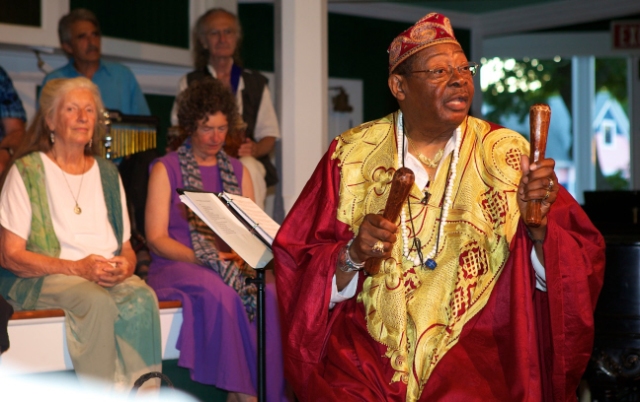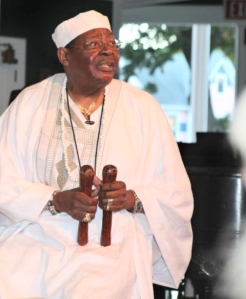We are a gentle, angry people
and we are singing, singing for our lives . . .
— Holly Near
The spirituals choir sang at Union Chapel Saturday night. I knew it was going to be a good night when Malvina Forester found herself a four-hour parking place on Ocean Park. It was.
I just joined the choir this year. This time last year I heard them sing at East Chop lighthouse. Wouldn’t it be cool, I thought, to sing those songs with those people?
So this year I’m doing it.
I’m not a musician. I’m barely a singer. But my life has had one hell of a soundtrack. I’ve learned almost as much history from songs as I have from books. And you can’t immerse yourself in the songs of a people without feeling something of the experience behind those songs.
The spirituals are slave songs, the songs of African slaves on the North American continent from about 1619 through Emancipation, news of which didn’t reach Texas till 1865. They weren’t composed: they evolved in true folk tradition. They were work songs, and at the same time they were songs of aspiration, celebration, and resistance. Some, like “Keep Your Lamp Trimmed and Burning,” “Wade in the Water,” and “Swing Low, Sweet Chariot,” referred specifically to the Underground Railroad, the clandestine network that helped southern slaves escape to the north.
Jim Thomas, leader of the choir, founded the U.S. Slave Song Project in 2005 to educate the public about the songs. Jim has a powerful voice. He can speak, he can testify, he can preach, and damn can he sing! As a student at Fisk University, he sang with the Fisk Jubilee Singers — the group that in the late nineteenth century started bringing slave songs to a wider, and whiter, audience. Since then he’s sung with the Robert Shaw and Paul Hill Chorales and organized choirs in a variety of places. He talks about the history of the songs, and what they signify.
People who hear the songs learn a lot, but people who sing them learn even more. About yearning for a better world, where even slaves would live “In Bright Mansions Above.” About determination to keep moving forward, as in “Don’t You Let Nobody Turn You Round,” “Done Made My Vow to the Lord,” and “Woke Up This Morning (With My Mind Stayed on Freedom).” About the courage and sly humor it took to sing songs that meant one thing to the masters and something entirely different to the slaves.

Jim in another of his wonderful robes. That’s me in purple beside the pillar, Gail Tipton on my left, percussionist Bob Lee behind me, and Alex Palmer behind Gail. Photo by Adrianne Ryan.
We sang again at the Unitarian Universalist service on Sunday morning. Union Chapel and the UU meeting house are two of my favorite places on Martha’s Vineyard, and they’re great places to sing.
Sunday night I went to hear Holly Near at the Old Whaling Church, a performance produced by the UUs and the Vineyard Peace Council. Holly was big on the soundtrack of my D.C. days — I heard her live several times and sold her records at Lammas Bookstore. Ever since I left town, the recording made on her 1984 “Lifeline” tour with Ronnie Gilbert, once of the Weavers, has been high on my playlist.
The Weavers were slightly before my (conscious) time, but as a young antiwar activist I learned their story, how they were blacklisted during McCarthyism’s heyday. Turned out I already knew many of the songs the Weavers had helped make popular, like “Goodnight, Irene,” “Follow the Drinking Gourd” (which is identified with the Underground Railroad), “Pay Me My Money Down,” and “So Long, It’s Been Good to Know You.” And of course I knew of Pete Seeger, a key troubador of the antiwar movement who had strong ties to the civil rights movement too.
In Wasn’t That a Time (1982), the wonderful documentary about the Weavers, there’s a magical sequence where Ronnie Gilbert and Holly Near sing together. (That’s a link to this very scene, which I just discovered on YouTube.) Holly had been part of Ronnie’s tradition from an early age; as they talk and sing together, you see Ronnie becoming part of the tradition that Holly was helping to create. The song they sing is Holly’s “Hay Una Mujer Desaparacida,” memorializing women who were “disappeared” by the U.S.-backed junta in Chile — which draws another musical tradition into the great current, that of La Nueva Canción, the “New Song” movement that rose in Latin America in the early 1960s.
Songs can pull you into experiences you’ve never had and traditions you weren’t born into. Singing together raises power and spirits. As I drove home Sunday night (singing along with one of Springsteen’s Seeger Sessions CDs), planetary survival seemed possible and writing worth doing. Since then the usual doubts have returned, but their influence is muted.
I’m thinking about what we’ve been losing over the last generation or so, as we retreat to our CD players and home entertainment centers to listen to recorded music instead of making it with each other in public spaces. Churches are among the few places where communal singing happens regularly — and look at all the wonderful singers who’ve been trained up in a church!
There’s plenty of music making on Martha’s Vineyard, but not much of it happens at demonstrations and vigils and other places where we gather to make ourselves heard. Five Corners is a favorite place for protests because it’s so visible, but it’s a lousy place for singing. Could that be a big reason that so few people show up?



Holly Near’s voice remains clear, lyrical, lovely — her choice, for these many decades, to use it for political and social action is a guidepost for all of us.
I love Jim Thomas and his choir — sorry to miss the performance at the East Chop LIghthouse this year. When this choir sings it makes me want to dance and sets my spirit free — some true lightness of being happens.
LikeLike
this post generated so many streams of thought, tumbling over each other like rapids in a river. Holly Near — terrific — she performed at St. Olaf in the mid-70s.
the power of song, particularly community song. slave songs are a particularly good example of the power of shared song to unite a community deliberately separated by “owners,” and to solidify the community of slaves within a single plantation. solidarity through song. something happens to you physically when you sing, and something extra happens when you sing with a group of people. more so when you sing songs you love or songs whose message you believe in. endorphins? whatever it is, it can bond people.
protesters today don’t sing. protests today seem less civil, and sometimes less focused. maybe if protesters put away their ipods and sang some good rousing protest songs, things would go better, and people might even be more receptive to their message. protesters are different today, too, though. many are semi-pros who follow the protest circuit, and protest whatever needs protesting. they’re gypsies, not so much committed to a particular cause. hard to imagine that sort of cast sitting down and singing good old-fashioned spirituals and protest songs.
LikeLike
Thanks for the wonderful memories Susanna! Back in the early 70’s I was promoted several Blues concerts. I got to meet many of the old masters. One thing I remembered is that they always insisted on a cash payment before they would perform. They had been screwed over so many times by record companies, crooked managers, and promoters that many of the greats were near destitute. The Folk & Blues boom of the 60’s/70’s finally gave them some bargaining power and I considered it an honor to pay the masters of the blues “cash on the barrel-head” for the musicians. About 15 years later I managed to get to a Holly Near concert in Barre Vermont. I still treasure the remembrance of that concert as well as the CDs I picked up. great performer!
LikeLike
Susanna I thought Woke Up This Morning was the Soprano’s theme song ;-)…Grew up listening to the Weavers…Mika Seeger was my best friend in grade school and I spent many a night in Pete’s self built log cabin overlooking the beautiful Hudson Valley. One of the things I remember the most was a hammered copper sink. Funny what we remember.
LikeLike
Excellent post, excellent memories you conjure of that Weavers documentary, and of some great songs and singers. And that’s why I love folk festivals: lots of great singing and songs including political songs and people often joining in to sing along. Although there seem to be far fewer younger singers singing about anything other than love and navel-gazing, or else they write surreal, almost nonsensical lyrics, which though often intriguing don’t yield much in the way of political commentary. Or am I just not finding those with something to say?
LikeLike